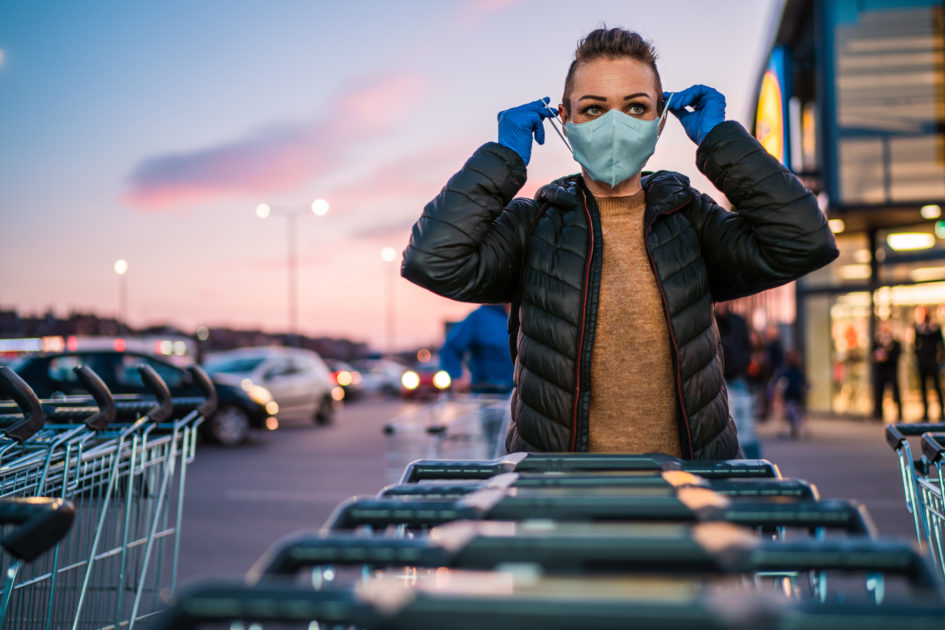Grocery shopping is an essential part of life. But during these uncertain times, and with the fear of contracting COVID-19 or carrying it home to loved ones, taking extra precautions when grocery shopping is necessary.
It can be hard to know where to start and how to prepare, so we’ve created this simple guide to help reduce anxiety before and after your next shopping trip.
Firstly, if you have any symptoms of illness, avoid grocery shopping altogether. Opt for a delivery service or no-contact pick-up option, if available.
If you are well, follow the steps below for grocery shopping safety tips:
AT THE STORE
- Ideally, send only one person (a head of household) to the grocery store at a time. Do not bring your entire family with you to the store.
- At this time, the best thing you can do to protect yourself when shopping, according to the CDC, is to not touch your face and use hand sanitizer and wash your hands frequently.
- Bring a paper shopping list rather than your phone to reduce contamination. Throw the list away before you leave the store.
- Bring only the card you need into the store, rather than your entire purse or wallet.
- Attempt to stay at least six feet apart from people, other than your immediate family, during your shopping trip. Follow this guideline especially when in line to check out.
- Avoid racing to get the last of an item on the shelf. Follow guidelines that may be posted at the store. Be patient.
- Bring hand sanitizer with you to the store to use every time you accidentally touch a “high-touch” surface, such as an unsanitized shopping cart.
“The virus causing COVID-19 can survive on surfaces and objects for a limited amount of time. The available evidence suggests this up to about three days on hard surfaces like metal or plastic and about one day on soft surfaces like cardboard,” according to Harvard. “This is unlike some other viruses that can persist on food or other surfaces for long periods.”
- Clean your shopping cart or basket—specifically the handles and other surface areas—either with your own disinfectant or wipes provided by the store. (Many stores have already started providing wipes by the carts.)
CHECKING OUT/PAYING FOR YOUR ITEMS
- When checking out, try to keep as much distance between yourself and the cashier as possible. If you have a self-service checkout option, choose that so you can bag your own items.
- If you don’t have the option to go cashless or contactless when paying for your groceries, make sure to wipe your credit card before and after use.
- Make sure you wash your hands before and after you pay, regardless of how you do it.
ONCE YOU’RE HOME
- Once you are home, always wash your hands before and after handling food items and unpacking groceries.
- If you can help it, do not place bags on your countertop when putting items away. This will make it easier to sanitize the floor afterward.
- Make sure you sanitize and wipe down all surfaces before and after you prepare food.
- Wash fresh produce as you normally would, under running water. For extra precaution, you could use a vegetable brush when cleaning your produce. Scrub and use a small amount of soap.
- For items that need to be immediately frozen or refrigerated (specifically frequently touched items, such as milk), you may wish to wash the container surface with a small amount of soap and water. Be sure to wash your hands after.
- You may also wish to sanitize car door handles and house doorknobs if you have touched them without sanitizing your hands.
- For items that do not need immediate attention, let these items sit outside or in your garage for three days.
“Because of the limited ability of coronavirus to survive on surfaces, the easiest way to minimize risk of infection from foods purchased at a store or delivered to your home is just let it sit in an out-of-the way place for three days,” says Harvard. “Of course, this won’t work for foods that need immediate refrigeration or freezing. Note that COVID-19 is an enveloped virus, meaning that it is covered in an oily membrane. Fortunately, plain soap is very effective at disrupting the oil on surfaces, and water is effective at removing and rinsing away the virus.”
The Food and Drug Administration (FDA) recommends four steps for safely dealing with food: Clean, Separate, Cook, and Chill. Visit the FDA for more frequently asked questions about COVID-19 including food safety.
“Food and Safety and the Coronavirus Disease 2019 COVID-19,” U.S. Food & Drug Administration, fda.gov, March 31, 2020.
“Food Safety, Nutrition, and Wellness During COVID-19,” Harvard School of Public Health, March 27, 2020.
“How Can You Safely Grocery Shop in the Time of Coronavirus? Here’s What Experts Suggest,” Madeleine Carlisle, Time, March 27, 2020.
“PSA Safe Grocery Shopping in COVID-19 Pandemic UPDATED!!! www.DrJeffVW.com,” Jeffrey VanWingen, Youtube.com, March 24, 2020.


1 Pingback